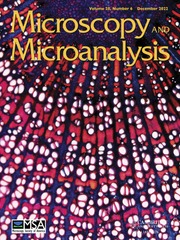No CrossRef data available.
Article contents
The Characterization and Phase Transformation in Iron Oxides
Published online by Cambridge University Press: 02 July 2020
Extract
In the processing of sheet steel, slabs are normally heated in a reheat furnace in the temperature range of 1200° -1300° C, extracted, hot rolled on a hot strip mill (HSM) and further processed. Because of the high operating temperature and the availability of oxygen, the steel surface is usually severely oxidized. The furnace scale could be a few millimeters thick. Abnormally thick scale may not be easily removed by high-pressure water sprays at the HSM. Rolled-in scale can contribute to underpickling and potentially result in the generation of steel surface defects.
Furnace scale typically consists of three oxide layers, Fe2O3 (hematite) on the outside surface, Fe3O4 (magnetite) in the middle and FeO1+x (wustite) next to the steel substrate. An example is shown in Figure 1. The three oxide layers are identified by H (hematite), M (magnetite) and W (wustite). Furnace scale samples of low carbon steel have been analyzed via x-ray diffraction (XRD) and optical metallography in order to characterize the scale.
- Type
- Oxidation/Corrosion
- Information
- Copyright
- Copyright © Microscopy Society of America


